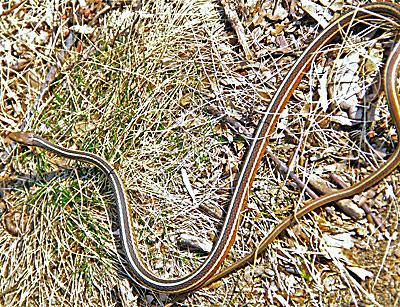Nature Notes: Signs and Wonders

On Monday evening after a record high temperature for March 12 I went out at night to listen for spring peepers. Between 8:30 and 10, I visited 11 known peeper breeding sites and heard not a single peep. The sites were watery, but apparently not watery enough. Peepers and other frogs and toads that breed in water, as do all of ours on Long Island and all but one of our salamander species, generally don’t move from the ground until there’s a rain, and it hasn’t rained sufficiently for at least two weeks now.
However, there are many other signs of an early spring to be found. By this date just about everyone has witnessed flowering crocuses and daffodils. A rather rare Asiatic species of bush honeysuckle, Lonicera smithsonii, with leathery leaves and pale white flowers, has been blooming since the last days of February in North Sea and Noyac. The diminutive European mustard with tiny white flowers has been blooming in spots along Noyac Road for a few days now. I would not be surprised to see a dandelion pop out in someone’s lawn before the week is done.
Alewives have been leaving the sea and swimming up into North Sea’s Big Fresh Pond since Feb. 25. The very early alewife run raised the question, would the osprey’s favorite food item hasten an early osprey return, as well? Howard Reisman lives on the edge of North Sea from whence the alewives run and keeps track of the birds that feed on them. As of Sunday, he had observed a pair back on the Scallop Pond platform in North Sea and a single one on the platform within eyesight of his back deck.
Last Thursday afternoon during a walk through the state’s part of Hither Woods in Montauk, there was a large ribbon snake half-coiled on one of the trails. Ribbon snakes look like very thin garter snakes and are rather uncommon. They are good swimmers. One of their favorite foods is spring peepers, which prompted me to go out listening on Monday night. When spooked, the snake quickly slithered into the adjacent leaf litter and out of sight. Most snakes don’t leave their winter hibernaculas until April, this one made a very big exception.
The beach grass on the backshore and narrow area of small dunes at the bottom of the eroding bluffs at the north edge of Hither Woods was already beginning to send up fresh green shoots, unheard for this time of the year. While, apparently, it was still too early for the mourning cloak butterflies, there were swarms of tiny flying insects, thrips or midges, circling in the air five to six feet above the ground. They need fresh water to lay their eggs in and Fresh Pond, a k a Hidden Pond, was merely a stone’s throw away. The swamp maples bordering the pond had swollen red flower buds ready to pop.
Fresh Pond is very high at this time, as high as I have ever seen it, similar in stature to Fort Pond two miles to the east. Fresh beaver work was apparent. Saplings of two-inch oaks and hickories were symmetrically gnawed through about a foot off the ground. Only the pointed stumps remained. There is a strong possibility that the Fresh Pond beaver is the same one that occupied Scoy Pond in Northwest for three years running beginning around 2005. It was seen and photographed on Napeague heading easterly more than three years ago. Signs of beaver were everywhere, but there was no sign of the beaver itself.
The shiny purple grackle males have been back for a few weeks. In my yard in Noyac the coating of oak leaves that I never rake up provide them with a little recreation, the leaf upending game. For hours they walk around flipping over leaves looking for edibles. It’s an antecedent to tool using, the proto-tools are their sturdy pliers-like beaks. In another generation or two they will be fashioning sticks into rakes in order to the job more efficiently.
Crows are already paired and feeding along the shoulders of roads, having abandoned their winter roosts with thoughts of spring in the air. Winter waterfowl have been leaving prematurely. On Sunday when it was almost dark, scores of Canada geese noisily passed overhead on their way north. You may have noticed that the geese have disappeared from most of the farm fields by now, and the large winter congregation on Shorts Pond in Bridgehampton has pretty much thinned out to but a few birds. Several local geese, along with mallards, have already paired up and can be seen flying low here and there, or standing at the edges of salt marshes and freshwater ponds getting ready for nest building and breeding.
It wouldn’t surprise me at all if shads started to bloom by the beginning of April. A late March or early April cold snap or snowstorm would be disastrous; it would set the advance of spring back to zero.
